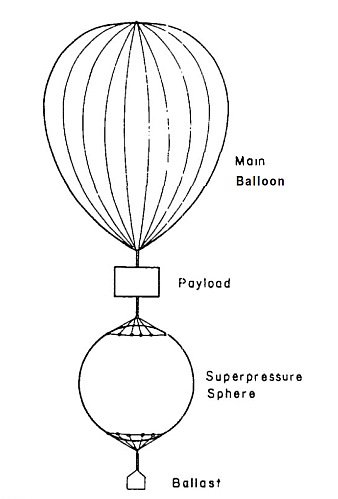Purpose of the flight and payload description
The Sky Anchor System was a two balloon system developed and tested by the National Scientific Balloon Facility (NSBF), during the 70's and 80's decade as part of a long lasting effort of the agency to develope a long duration balloon system. The concept -originally tested in a small scale in 1963- was boosted by the needs of the scientific ballooning community which could benefit in many areas of interest from longer exposure times at altitude. The final goal of the developmental effort was to built a vehicle capable of transport a 500 lb scientific payload at 130,000 ft for a minimum of 100 days duration.
The Sky Anchor system used a two balloon system on which a conventional zero pressure balloon (open) carried below a super pressure balloon (closed) which acted as ballast and anchor. In the image at left is a basic scheme of the system (a more detailed description can be seen clicking over the drawing).
The theoretical operation of the system was as follows. Once the system was airborne, on the way to the main balloon's operational altitude, the super pressure became filled and pressurized. As the "super pressure" continued to be carried upward it losed more and more lift. When sunset occured the entire system descended to a new equilibrium altitude where the increase in lift on the super pressure balloon just equaled the sunset effect on the main balloon. Although its volume was decreased, no gas was lost from the main balloon. At sunrise, the main balloon expanded and the system once again rose. In so doing the super pressure balloon losed the lift that it gained at sunset and the system stabilized at the same altitude as the preceding day. Since there was no change in suspended weight on the main balloon, it should not overshoot and again there will be no loss of gas. As in the pure super pressure system, assuming there were no leaks, the flight duration was limited only by creep, gas diffusion and ultraviolet degradation of the balloon fabric.
Throughout the development of the program, the actual flight experience turned out to be much more complex than planned, so after mixed results on 14 flights over six years, the program was abandoned in 1982. However, the experience gained would pave the way for other groups to develop more successful designs in the future. This would allow the original goal behind Sky Anchor to be achieved in the early decades of the 21st century.
Details of the balloon flight
Balloon launched on: 6/20/1979
Launch site: Columbia Scientific Balloon Facility, Palestine, Texas, US
Balloon launched by: National Scientific Balloon Facility (NSBF)
Balloon manufacturer/size/composition: Zero Pressure Balloon Raven 14.158 m3 (19.00 microns - X-124) - Raven 5.125 (23 x 23 microns Celanar)
Flight identification number: 1150PT
End of flight (L for landing time, W for last contact, otherwise termination time): 6/21/1979
Balloon flight duration (F: time at float only, otherwise total flight time in d:days / h:hours or m:minutes - ): F 15 h 30 m
Landing site: Near El Paso, Texas
Payload weight: 174 kgs.
This was the ninth test flight of the system. Sky Anchor IX mission was launched from the National Scientific Balloon Facility in Palestine, Texas in the evening of 20 June 1979. The balloon system consisted of a 500.000 cubic feet zero pressure balloon, a 323 lb payload and a 181.000 cubic feet super pressure anchor balloon. The launch went as planned except for a brief scare when the super-pressure spool would not open. This caused the zero-pressure balloon and test package to bounce around in a tethered condition briefly until the spool was forced open. The system survived without any apparent damage and went on to fly successfully.
Ascent went normally, all ballast was dropped, and the balloon system reached a night float altitude of 27.7 Km (91.0 Kft). The system rose to 28.5 Km (93.5 Kft) the next day and was terminated that afternoon after a very successful 16 hour float. The package was recovered in good condition near El Paso, Texas, marking the second successful flight of the system.
External references
- Advances in long duration, high altitude flights Advances in Space Research, Volume 1, Issue 11, 1981, Pag. 193
- National Scientific Balloon Facility Annual Report FY 1979 National Center for Atmospheric Research, September 1980
5597If you consider this website interesting or useful, you can help me to keep it up and running with a small donation to cover the operational costs. Just the equivalent of the price of a cup of coffee helps a lot.



